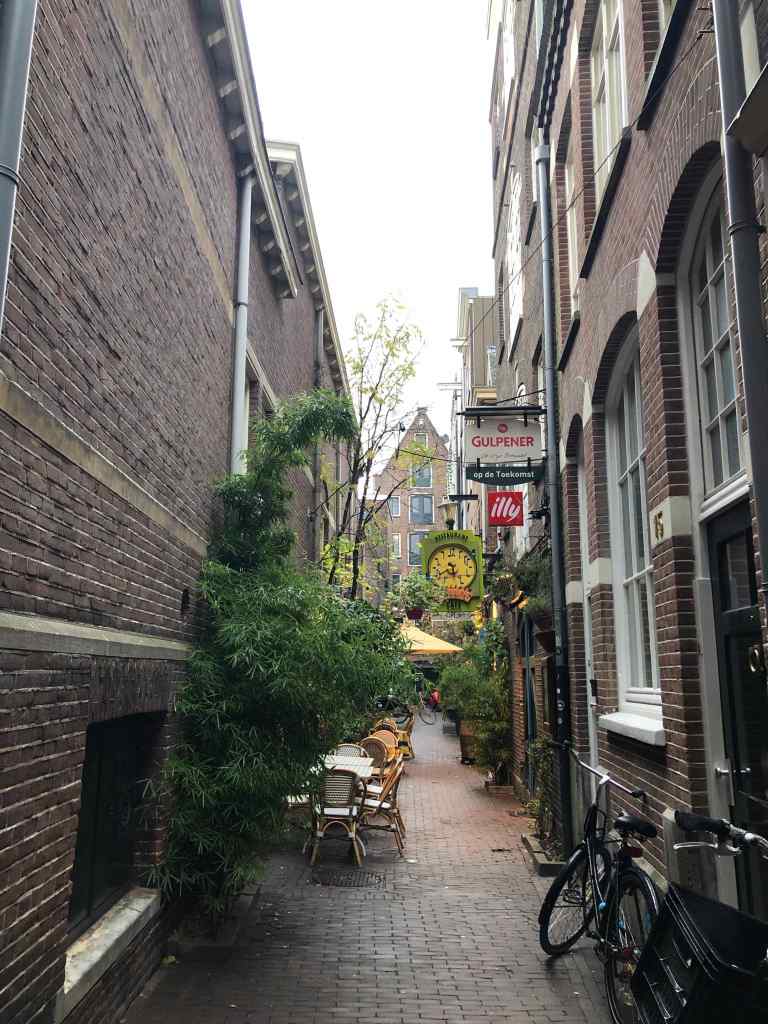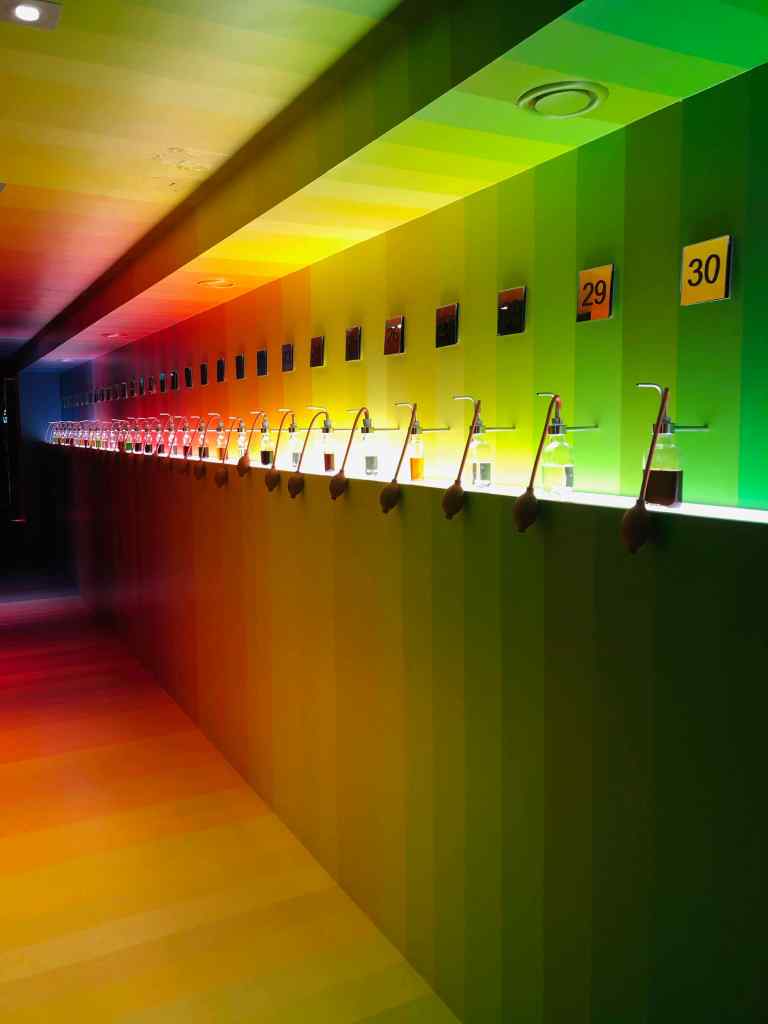We arrived in Amsterdam yesterday afternoon, straight off of a true red eye. Despite our best efforts, we ultimately succumbed to jetlag and spent most of our first day catching up on sleep. We woke around 6am and headed (not so bright) and early to explore the city, as we only budgeted a day in Amsterdam before heading to Germany for Christmas. We started the morning with a nice walk around the northern part of the city in the dark and rain.

Most restaurants don’t open until 8am, so we enjoyed a quiet stroll along the canals for about an hour, dipping into the only open neighborhood cafe to grab a healthy and nutritious* (read: mostly whipped cream) pre-breakfast treat to get out of the rain.

After our snack, we continued strolling towards our breakfast destination as the sun finally started to rise around 8:30am: the acclaimed Omelegg restaurant, which specializes in omelettes and egg dishes. It was delicious – I ordered the “Christmas Tree” special, which was a decadent omelette filled with pesto, sun-dried tomato, gouda cheese, and spinach; we also tried an omelette with ham, jalapeños and mushrooms.

Completely full after our two breakfasts, we proceeded to our first museum of the day, heading to the Red Light District for the Museum of Prostitution. The museum’s primary goal is to demystify the Red Light District’s main offering, and to raise awareness for programs which support legal efforts to curb human trafficking in the area. It was an interesting museum and not nearly as seedy as I had expected – the information was tactfully presented and quite informative. A couple interesting tidbits:
- It was Napoleon who first legalized prostitution in the Red Light District; during those times, women would go twice weekly for a medical exam to ensure their health. Those who were healthy would receive a ‘red’ card, and those with an infection / disease would receive a ‘white’ card and receive free treatment but could no longer work
- Legalization has come and gone over the years, and only in 2000 were brothels formally legalized, requiring a permit to operate
- Prostitutes are considered ‘self employed’ and have to pay income tax “as with any other entrepreneur”
- Selecting services from a window costs a flat fee, while a brothel charges by the hour; you typically receive better ‘service’ in a brothel as they are enticing you to stay and pay more
- The average ‘encounter’ from a window lasts 6-15 minutes
Overall, it was a worthwhile museum to visit; that said, walking through the Red Light District in plain, early morning daylight meant we saw a lot of empty windows and small rooms each containing a bed and a toilet, not unlike a jail cell, being cleaned in order to welcome tonight’s visitors. Certainly an eye opening experience, but not one I’d seek out again.

After the Red Light District, we wandered towards the Museum Square, hoping to visit a couple during the afternoon. We wandered past several beautiful canals and churches on the way.




We started at the Rijks Museum, where we enjoyed both the normal exhibition as well as a free special exhibition which contrasted Dutch masters like Rembrandt with Spanish masters like Velazquez. The exhibition paired sets of paintings on a similar theme and juxtapose how the artists portrayed the topic (i.e., man’s struggle with against nature).
Otherwise, the museum highlights a variety of artists, mostly Dutch, from the 1100s-1900s; we spent most of our time in the 1100s exhibit and in a series of galleries which showed art gathered over the Dutch colonial period. Most interesting pieces included:
- A series of dioramas showing daily life in Paramaribo, Suriname during the colonial period, which Europeans would have purchased as souvenirs
- A series of portraits of Javanese officials wearing beautiful Batik garments
- A variety of Japanese chests and wood-works
- A collection of glasses and other vessels intended to be used for drinking games, although the rules are no longer known. My favorites included:
- A series of cups shaped like cannons, which meant they couldn’t be put down or the liquid would spill, forcing the holder to drink the full glass at a time
- A glass with a ‘trick’ neck, which would spill if the drinker didn’t tilt it a certain way
- A set of glasses with attachments shaped like windmills with numbers on them – the best speculation is that blowing on the windmill will produce a number, which might correspond to the person taking the drink, or the number of drinks that person would need to take
Of course, there were also famous Dutch paintings, like the self-portrait of Van Gogh. After the museum, we decided to rest our feet for a bit and sought out Surinamese food, which turns out to be a combination of Indonesian and Chinese cuisines with a little twist. Although we were the first people at the restaurant, Warung Spang Makandra, it soon filled up with plenty of locals, including several police officers.


We ordered the bami goreng and the roti, which was served with a large, doughy pancake. The noodles were delicious and tasted like classic mee goreng, one of my favorite Indonesian dishes; the roti was essentially a yellow chicken curry with egg, potato and green beans. Both were delicious – and the total was under 20 Euro!

After lunch, we braved the chilly day again for a main highlight of our European trip: the Christmas Market! While Germany is known for its Christmas markets (and Cologne’s market is among the best, which is why we’re heading there tomorrow), many other European countries have a similar tradition and the Netherlands is no different. It’s a very small area on the Museum Square, but provided some great ambiance nonetheless.

The primary focal points of the Amsterdam Christmas Market were the ice skating (with the beautiful Rijks Museum in the background) and, of course, the gluhwein stand, where they mull wine over an open flame.

After the Christmas Market, we tried to hit the Van Gogh Museum, but tickets were sold out. Of course, there’s nothing a good cocktail can’t fix, so we headed across the street to the Bols Museum to learn more about the history of cocktail making – it also didn’t occur to me until we arrived that Bols refers to not only the name of the family, but the eponymous set of liqueurs (notably a cheaper version of triple sec I’ve often substituted for Grand Marnier). The museum is tailored to a younger crowd, and they do a great job of knowing their audience and making it informative and experiential.

The journey starts with an overview of the history of the Bols liquor brand, including the way different spices like coriander were ‘discovered’ by the Dutch East India Trading Company and then leveraged for spirits like gin; it then goes into a detailed overview of the production process.


Of course, the tour had to entice us with a couple freebies, including an ‘experiential’ shot of a special liqueur (which they video and all you to download at the end if you desire). They provide you with a small vial at the beginning of the tour, and at a certain point, you’re ushered into a private, sound-proof booth and given instructions on how to take the shot, complete with music, vibrations, and light changes. The vial itself contains a fascinating shot which starts sweet and ends with a kick of Szechuan peppercorn, which tingles / numbs your tongue.
From there, you’re taken through a series of atheistically-pleasing rooms and finally to the bar, where you can select a cocktail from their extensive list (included with the ticket). We tried the traditional ‘genever’ (essentially a Dutch bourbon, but using ingredients associated with gin) and a rosemary infused gin, both of which were delicious.


After that, having walked nearly 10 miles, we headed back to the hotel to rest before dinner. For dinner, we enjoyed another of the Netherlands’ colonial exports: a Rijsttafel, or large meal of Indonesian food at Tujuh Maret.

Despite the photo quality, it was absolutely delicious, and included 24 items:
- 2 types of rice, one of which was standard white rice flavored with pandan, and one which was a spiced rice with chiles
- Garnishes, including prawn crackers, a relish and coconut / peanut topping (intended to mitigate the spiciness of some of the dishes, so we skipped it!)
- Chicken satay
- 6 “mild” dishes, including a delicious beef in coconut broth, salad, green beans, chicken in curry, and some kind of nut-based brittle
- 6 “medium” dishes, including bok choy, chicken with peanut sauce, beef rendang, a different green bean preparation and another chicken curry dish
- 6 “spicy” dishes, including beef, eggplant puree, a spiced egg, and a chicken dish with chiles
Overall, our favorite dishes were actually those in the ‘medium’ and ‘mild’ categories, since it almost felt like the ‘spicy’ dishes were spicy for spiciness sake, without the same complex flavors as the others. The chicken satay was another favorite as well! It certainly brought back some of my favorite flavors from living in Indonesia as a child, including a couple flavor combinations I forgot I knew and enjoyed – I wish I had a full recipe list to know what these dishes are called!
